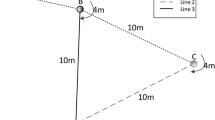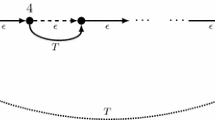Abstract
Customer-oriented optimization of public transport needs data about the passengers in order to obtain realistic models. Current models take passengers’ data into account by using the following two-phase approach: In a first phase, routes for the passengers are determined. In a second phase, the actual planning of lines, timetables, etc., takes place using the knowledge on which routes passengers want to travel from the results of the first phase. However, the actual route a passenger will take strongly depends on the timetable, which is not yet known in the first phase. Hence, the two-phase approach finds non-optimal solutions in many cases. In this paper we study the integrated problem of determining a timetable and the passengers’ routes simultaneously. We investigate the computational complexity of the problem and present solution approaches which are tested on close-to-real-world data.



Similar content being viewed by others
References
Anhalt J (2012) Eine iterative Heuristik für aperiodische Fahrplangestaltung mit OD-Paaren. Master’s thesis, Georg-August-Universität Göttingen (in German)
Bellare M, Goldwasser S, Lund C, Russel A (1993) Efficient probabilistically checkable proofs and applications to approximation. In: STOC ’93 Proceedings of the twenty-fifth annual ACM symposium on Theory of computing. ACM, New York, USA, pp 294–304
Borndörfer R, Grötschel M, Pfetsch ME (2007) A column-generation approach to line planning in public transport. Transp Sci 41(1):123–132
Borndörfer R, Grötschel M, Pfetsch ME (2008) Models for line planning in public transport. In: Hickman M, Mirchandani P, Voß S (eds) Computer-aided systems in public transport, vol 600., Lecture notes in economics and mathematical systemsSpringer, Berlin, pp 363–378
Dollevoet T, Huisman D (2011) Fast heuristics for delay management with passenger rerouting. Tech rep. Econometric Institute, Erasmus University Rotterdam
Dollevoet T, Huisman D, Schmidt M, Schöbel A (2012) Delay management with re-routing of passengers. Transp Sci 46(1):74–89
Feige U (1998) A threshold of ln n for approximating set cover. J ACM 45:634–652
Fischetti M, Monaci M (2009) Light robustness. In: Ahuja RK, Möhring R, Zaroliagis C (eds) Robust and online large-scale optimization., Lecture note on computer scienceSpringer, New York, pp 61–84
Fischetti M, Salvagnin S, Zanette A (2009) Fast approaches to improve the robustness of a railway timetable. Transp Sci 43:321
Garey M, Johnson D (1979) Computers and intractability—a guide to the theory of NP-completeness. Freeman, San Francisco
Goerigk M, Schöbel A (2010) An empirical analysis of robustness concepts for timetabling. In: Erlebach T, Lübbecke M (eds) Proceedings of ATMOS, OASIcs, vol 14. Schloss Dagstuhl-Leibniz-Zentrum für Informatik, Dagstuhl, Germany, pp 100–113
Goerigk M, Schöbel A (2012) Improving the modulo simplex algorithm for large-scale periodic timetabling. Computc Oper Res. doi:10.1016/j.cor.2012.08.018
Gurobi Optimizer (2011). http://www.gurobi.com/. Gurobi Optimizer Version 4.5.1, Houston, Gurobi Optimization Inc., Texas
Kinder M (2008) Models for periodic timetabling. Master’s thesis, Technische Universität, Berlin
Krasemann J (2012) Design of an effective algorithm for fast response to the rescheduling of railway traffic during disturbances. Transp Res Part C 20:62–78
Liebchen C (2006) Periodic timetable optimization in public transport. Ph.D. thesis, Technische Universität, Berlin, Published by dissertation.de.
Liebchen C, Lübbecke M, Möhring R (2009) The concept of recoverable robustness, linear programming recovery, and railway applications. In: Ahuja RK, Möhring R, Zaroliagis C (eds) Robust and online large-scale optimization. Springer, New York
Liebchen C, Proksch M, Wagner FH (2008) Performance of algorithms for periodic timetable optimization. In: Fandel G, Trockel W, Hickman M, Mirchandani P, Voß S (eds) Computer-aided systems in public transport, vol 600., Lecture notes in economics and mathematical systemsSpringer, Berlin, pp 151–180
Lindner T (2000) Train schedule optimization in public rail transport. Ph.D. thesis, Technische Universität Braunschweig
LinTim - Integrated optimization in public transportation (2011). http://lintim.math.uni-goettingen.de. Accessed 09 Nov 2011
Lübbe J (2009) Passagierrouting und Taktfahrplanoptimierung. Master’s thesis, Technische Universität Berlin (in German)
Lusby R, Larsen J, Ehrgott M, Ryan D (2011) Railway track allocation: models and methods. OR Spectr 33:843–883
Nachtigall K (1998) Periodic network optimization and fixed interval timetables. Deutsches Zentrum für Luft- und Raumfahrt. Institut für Flugführung, Braunschweig. Habilitationsschrift
Nachtigall K, Opitz J (2008) Solving periodic timetable optimisation problems by modulo simplex calculations. In: Fischetti M, Widmayer P (eds) Proceedings of ATMOS. Schloss Dagstuhl - Leibniz-Zentrum für Informatik, Germany
Nemhauser GL, Wolsey LA (1988) Integer and combinatorial optimization. Wiley, New York
Odijk MA (1996) A constraint generation algorithm for the construction of periodic railway timetables. Transp Res Part B 30(6):455–464
Odijk MA (1998) Railway timetable generation. Ph.D. thesis, Technische Universiteit Delft
Peeters L (2003) Cyclic railway timetable optimization. Ph.D. thesis, Erasmus University Rotterdam
Pfetsch M, Borndörfer R (2006) Routing in line planning for public transport. In: Haasis HD, Kopfer H, Schönberger J (eds) Operations Research Proceedings 2005, vol 2005. Springer, Berlin, pp 405–410
Rockafellar RT (1984) Network flows and monotropic optimization. John Wiley & Sons, Inc., New York
Schmidt M (2012) Integrating routing decisions in network problems. Ph.D. thesis, Institute for Numerical and Applied Mathematics, Georg-August-University Göttingen
Schmidt M (2012) Line planning with equilibrium routing. Tech rep, Institut für Numerische und Angewandte Mathematik, Georg-August Universität Göttingen
Schmidt M (2013) Simultaneous optimization of delay management decisions and passenger routes. Public Transp 5:125–147
Schmidt M (2014) Integrating routing decisions in public transportation problems, optimization and its applications. Springer, New York
Schmidt M, Schöbel A (2010) The complexity of integrating routing decisions in public transportation models. In: Erlebach T, Lübbecke M (eds) Proceedings of ATMOS, OASIcs, vol 14. Schloss Dagstuhl-Leibniz-Zentrum für Informatik, Dagstuhl, Germany, pp 156–169
Schöbel A (2006) Optimization in public transportation. Stop location, delay management and tariff planning from a customer-oriented point of view. Optimization and its applications. Springer, New York
Schöbel A (2012) Line planning in public transportation: models and methods. OR Spectr 34(3):491–510
Schöbel A, Kratz A (2009) A bicriteria approach for robust timetabling. Lect Notes Comput Sci 5868:119
Schöbel A, Scholl S (2006) Line planning with minimal travel time. In: 5th Workshop on Algorithmic Methods and Models for Optimization of Railways, no. 06901 in Dagstuhl Seminar Proceedings
Serafini P, Ukovich W (1989) A mathematical model for periodic scheduling problems. SIAM J Discret Math 2:550–581
Siebert M, Goerigk M (2013) An experimental comparison of periodic timetabling models. Comput Oper Res 40(10):2251–2259
Acknowledgments
We want to thank the LinTim team and in particular Jennifer Anhalt for providing data and computing the numerical results. We also acknowledge the helpful comments of the anonymous referees and associate editor.
Author information
Authors and Affiliations
Corresponding author
Additional information
The research leading to these results has received funding from the European Union Seventh Framework Programme (FP7-PEOPLE-2009-IRSES) under grant number 246647 and the New Zealand Government (project OptALI).
Appendix
Appendix
Theorem 1 TTwR is strongly NP-hard even if all OD-pairs have the same origin.
Proof
We show this by reduction from the strongly NP-complete decision problem Set Cover (Garey and Johnson 1979) defined as follows: Given \(P=\{p_1,\ldots ,p_m\}\), a set of subsets \(Q=\{q^1,\ldots , q^n\}\) with \(q^j\subset P\) and a natural number \(K\), decide whether there is a subset \(Q'\subset Q\) with \(|Q'|\le K\) such that for every \(p_i\in P\) there is at least one \(q^j\in Q'\) such that \(p_i\) is contained in \(q^j\).
Let \((P,Q,K)\) be an instance of Set Cover with \(P=\{p_1,\ldots ,p_m\}\) and \(Q=\{q^1,\ldots , q^n\}\). Without loss of generality we assume that \(K< n\). Based on \(P\) and \(Q\) we construct an instance of TTwR in the following way:
We represent the elements \(p_i\in P\) by OD-pairs \((u,v_i)\) with passenger numbers \(w_{uv_i}:=K+1\).
The sets \(q^j\in Q\) are represented by a gadget consisting of three trains \((\mathrm{tr}^j)^1\), \((\mathrm{tr}^j)^2\) and \((\mathrm{tr}^j)^3\), six stations \(s_1,s^j_2,s^j_3,s^j_4, s^j_5,s^j_6\) (where \(s_1\) is the same station for all OD-pairs) and an OD-pair \((u,v^j)\) with \(u:=s_1\) and \(v^j:=s^j_5\) and \(w_{uv^j}:=1\), in the way depicted in Fig. 4.
The square nodes are the departure and arrival events where the train names are omitted in the node labels for the sake of a compact representation. The origin and destination events are represented by ovals. The dotted lines are the origin and destination activities, the solid lines represent driving and waiting activities, transfer activities are represented by dashed lines. The gray line indicates where it is possible to leave this gadget.
For every \(p_i\in q^j\) we introduce a train \(\mathrm{tr}_i^j\) running from \(s_3^j\) to a station \(v_i\) and connect \(((\mathrm{tr}^j)^2-s^j_3-\mathrm{Arr})\) to a departure event \((\mathrm{tr}_{i}^j-s^j_3-\mathrm{Dep})\) by a transfer activity with upper and lower bound \(u_{((\mathrm{tr}^j)^2-s^j_3-\mathrm{Arr}),(\mathrm{tr}_{i}^j-s^j_3-\mathrm{Dep})}:=0\) and \(l_{((\mathrm{tr}^j)^2-s^j_3-\mathrm{Arr}),(\mathrm{tr}_{i}^j-s^j_3-\mathrm{Dep})}:=0\). \((\mathrm{tr}_{i}^j-s^j_3-\mathrm{Dep})\) is connected to the arrival event of train \(\mathrm{tr}_{i}^j\) in \(v_i\) by a driving activity \(a\) with upper and lower bound \(l_a:=0\), \(u_a:=0\).
See Fig. 5 (in combination with Fig. 4) for an example of the construction for an instance of Set Cover with \(P=\{1,2,3,4\}\) and \(Q=\{\{2,3,4\},\{1,4\},\{2,3\}\}\). The square nodes are the departure and arrival events. The origin and destination events are represented by ovals. The dotted lines are the origin and destination activities, the solid lines represent driving and waiting activities, transfer activities are represented by dashed lines. The nodes \(g^j\) represent the gadgets from Fig. 4.
Summarizing, our instance \(I\) of TTwR is defined by the following input, which defines an EAN \(N\) with upper and lower bounds \(l,u\) and a set of OD-pairs \(\mathcal {OD}\):
-
a set of stations \(S=\{s_1\}\cup \{s_2^j,s_3^j,s_4^j,s_5^j:j=1,\ldots ,n\}\cup \{v_i:i=1,\ldots ,m\}\),
-
a set of trains \(\mathrm{TR}=\{(\mathrm{tr}^j)^1,(\mathrm{tr}^j)^2,(\mathrm{tr}^j)^3:j=1,\ldots ,n\}\cup \{\mathrm{tr}_i^j:p_i\in q^j\}\) where \((\mathrm{tr}^j)^1\) run on the paths \((s_2^j,s_5^j)\), \((\mathrm{tr}^j)^2\) run on \((s_1,s_2^j,s_3^j,s_4^j,s_5^j)\), \((\mathrm{tr}^j)^3\) run on \((s_1,s_4^j)\) and \(\mathrm{tr}_i^j\) run on \((s_3^j,v_i)\).
-
transfers
$$\begin{aligned} \mathcal {C}&= \{((\mathrm{tr}^j)^2,(\mathrm{tr}^j)^1,s_2^j), ((\mathrm{tr}^j)^1,(\mathrm{tr}^j)^2,s_5^j), ((\mathrm{tr}^j)^3,(\mathrm{tr}^j)^2,s_4^j): j=1,\ldots ,n\}\\&\cup \{((\mathrm{tr}^j)^2,\mathrm{tr}_i^j,s_3^j):p_i\in q^j\} \end{aligned}$$ -
a lower bound \(l_{((\mathrm{tr}^j)^1-s^j_2-\mathrm{Dep},(\mathrm{tr}^j)^1-s^j_5-\mathrm{Arr})}=1\) on driving activities \(((\mathrm{tr}^j)^1-s^j_2-\mathrm{Dep},(\mathrm{tr}^j)^1-s^j_5-\mathrm{Arr})\) for \(j=1,\ldots ,n\) and lower bounds \(l_a:=0\) on all other activities. The upper bounds are \(u_a=1\) for
$$\begin{aligned} a\in \{&((\mathrm{tr}^j)^1-s^j_2-\mathrm{Dep},(\mathrm{tr}^j)^1-s^j_5-\mathrm{Arr}),\\&((\mathrm{tr}^j)^2-s^j_2-\mathrm{Dep},(\mathrm{tr}^j)^2-s^j_3-\mathrm{Arr}), \\&((\mathrm{tr}^j)^2-s^j_4-\mathrm{Dep},(\mathrm{tr}^j)^2-s^j_5-\mathrm{Arr}): j=1,\ldots ,n\} \end{aligned}$$and \(u_a:=0\) otherwise.
-
The set of OD-pairs is \(\mathcal {OD}=\{(u,v^j):j=1,\ldots ,n\}\cup \{(u,v_i):i=1,\ldots ,m\}\) with \(u:=s_1\) and \(v^j:=s_5^j\). The weights are \(w_{uv^j}=1\) and \(w_{uv_i}=K+1\).
We show that there is a solution \((\pi ,\mathcal {R})\) to the constructed instance \(I\) with \(c_{\mathrm{TTwR}}(\pi ,\mathcal {R})\le K\) if and only if there is a subset \(Q'\) solving the Set Cover problem.
We observe that if for an OD-pair \((u,v_i)\) there is a gadget \(g^j\) such that \(u-{\mathrm{org}}\) is connected to \(g^j\) and there is a length of \(0\) assigned to \(((\mathrm{tr}^j)^2-s_2^j-\mathrm{Dep},(\mathrm{tr}^j)^2-s_3^j-\mathrm{Arr})\), the OD-pair will arrive at its destination in time \(0\) while if there is no such structure, there will be a contribution of \(n+1\) to the objective function. Thus, in a feasible solution, for every OD-pair \((u,v_i)\) there must be at least one gadget \(g^j\) such that \((\mathrm{tr}_i^j-s_3^j-\mathrm{Dep})\) is connected to \(g^j\) and there is a length of \(0\) assigned to \(((\mathrm{tr}^j)^2-s_2^j-\mathrm{Dep},(\mathrm{tr}^j)^2-s_3^j-\mathrm{Arr})\). Note that in this case it follows that the length of \(((\mathrm{tr}^j)^2-s_4^j-\mathrm{Dep},(\mathrm{tr}^j)^2-s_5^j-\mathrm{Arr})\) is \(1\), hence \(c_{\mathrm{TTwR}}(\pi ,P^j)=1\) for the corresponding timetable \(\pi \) and any path \(P^j\) chosen for OD-pair \((u,v^j)\).
We conclude that \(Q'\) is a solution to the considered instance of Set Cover if and only if assigning a length of \(1\) to \(((\mathrm{tr}^j)^2-s_2^j-\mathrm{Dep},(\mathrm{tr}^j)^2-s_3^j-\mathrm{Arr})\) for all \(j\) with \(q_j\in C'\) and a length of \(0\) otherwise leads to a solution to the constructed instance of TTwR with solution value \(\le \)K. \(\square \)
Rights and permissions
About this article
Cite this article
Schmidt, M., Schöbel, A. Timetabling with passenger routing. OR Spectrum 37, 75–97 (2015). https://doi.org/10.1007/s00291-014-0360-0
Published:
Issue Date:
DOI: https://doi.org/10.1007/s00291-014-0360-0






